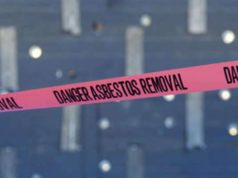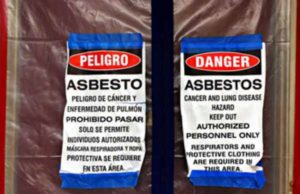
Asbestos in plaster is dangerous for a number of reasons, not the least of which is the fact that this material will degrade over time and release asbestos particles in the air. Asbestos is harmful as the strand-like particles of friable asbestos can be inhaled without the knowledge of the victim and the health effects might not appear for decades. Asbestos was used in plaster for a number of decades in the 20th century for its fire and waterproof qualities, cheap insulation and other desirable chemical properties. Its versatility and popularity made manufacturers ignore safety concerns and protected against regulation for an extended period of time. Only now do we understand the full danger posed by asbestos in plaster.
Why is plaster used in buildings?
Plaster generally serves no structural purpose in buildings and is finished as a decorative addition. This may disguise poor workmanship or damage, but can also be used to make a property more desirable. Plaster is a powder that water is added to and that can be manipulated into creative designs before it hardens.
What is the danger from asbestos in plaster?
Plaster used to decorate walls, join drywall or cover ceiling is dangerous when it is damaged, as it will leach asbestos into the air. This is because asbestos on its own is a friable material. Friable materials are broken apart easily with minimal pressure. When mixed with plaster, the asbestos is especially easy to dislodge. Since asbestos particles are tiny and indiscernible to the eye, it will also travel very well with even the lightest of wind current. This is why asbestos mining towns and shipyards have thousands people sickened, even when they did not work with asbestos or had frequent, direct exposure.
How to identify asbestos in plaster
Properties constructed between 1940 and 1980 may contain asbestos plaster, although these are not concrete dates. Prototypical asbestos plaster may have been used prior to 1940 and then ban on asbestos in building materials enacted during the 1970s allowed existing asbestos plaster to be used until it was exhausted. Therefore, any plaster in these structures is a suspect for contamination. Aside from the age of the plaster, there is no way the typical property owner can determine if the asbestos is present in the plaster.
An interesting bit of advice on asbestos is one that is not commonly known among the general population. Most experts assert that as long as the asbestos is sealed and not exposed or likely to crumble, it actually poses no threat to the health of occupants. This is because the asbestos in plaster that may sicken us can only do so through inhaling tiny fibers that break away from the source. These tiny fibers accumulate, causing increasingly worse symptoms. Asbestos fibers do not break down and usually embed themselves in the lungs or other organ linings. Therefore, prolonged exposure to friable asbestos is a major hazard.
All types of asbestos can potential be used in asbestos plaster, but the most likely culprit will be white serpentine asbestos, also known as Chrysotile. This accounts for 95% of asbestos used in the United States and was the most versatile that lent itself to applications such as insulation and coating.
What is a popcorn ceiling?
Popcorn ceilings were a popular application of asbestos plaster in the 60s and 70s. Mixed with water, plaster and other additives, this asbestos was sprayed on ceilings where it dried quickly. The result was a texture similar to popped corn kernels. This coating not only helped with fire and water proofing, it also helped to make the room soundproof. The issue with popcorn ceilings is that like plaster on walls, it may chip, crumble or degrade over time. This will lead to friable fibers released in the air.
Popcorn ceilings will be dealt with in two possible ways. An asbestos abatement professional may scrape off the coating after soaking it to prevent loose fibers from being released. Alternatively, the ceiling can be sealed with an additional adhesive coating. Once this coating adheres to the ceiling, asbestos fibers will not escape as long as the outside coating remains intact and unhampered.
How to have asbestos plaster removed
You should never attempt to remove asbestos on your own as it is a dangerous and tricky process. In fact, most amateurs that attempt asbestos abatement on their own often exacerbate the situation, exposing asbestos deposits that could have remained covered and spreading asbestos fibers even further than before. Wet applications are typically needed in abatement to prevent fibers from spreading. In addition, strong vacuums and HEPA filters are necessary to trap loose particles that are already present or have been disturbed by the removal. Trust an asbestos abatement professional to remove your asbestos plaster as this is your safest option.
How long will I need to be exposed to become ill with an asbestos related illness?
The answer is unclear and depends on a number of factors. The individual’s health plays a small role in determining is a lung disease will result from exposure to asbestos plaster. In this case, risk factors such as pollution and chronic smoking habits will speed the development of cancers that affect the lungs and linings. The most important factor is length and frequency of exposure. Those that have worked with the material extensively and in close contact, without adequate precautions are the most at risk. Most that were exposed to asbestos on an occupational basis will have moderate risk depending on safety precautions. An asbestos related illness for these individuals will take between 40 and 50 years to develop.
Due to the lengthy period of latency before the asbestos begins to affect the victim, it is easy to underestimate the potential danger from asbestos plaster. Appreciating the dangers and taking adequate precautions is essential to protecting them from accidental exposure. Remember to use only trusted asbestos abatement professionals to remove asbestos.
What do I do if I have become ill as a result of asbestos plaster?
If you are hurt by asbestos plaster, you may have legal recourse depending on your prior knowledge of the contamination. If you were not properly informed of the potential dangerous material in your home or place of work, you may be able to collect damages from the employer or property owner, provided you can prove that you can demonstrate that the exposure represents a willful negligence on their part to remedy the dangerous situation.
Manufacturers may also be held legally responsible for asbestos plaster as new products containing asbestos were banned after 1980. If this is a new product containing asbestos, the manufacturers will also face criminal penalties for criminal knowing endangerment. Products manufactured prior to the ban were allowed use until depleted, but the manufacturers may still be held liable for the asbestos content in the plaster.
Class action suits were likely filed against the manufacturer of the asbestos plaster in question. If this is the case, you might have been included in the settlement, without your knowledge. You would have needed to opt out of class action in order to purse your own litigation. Consulting with a mesothelioma attorney will help you file a legitimate claim for compensation for medical expenses, lost wages and other damages.




























